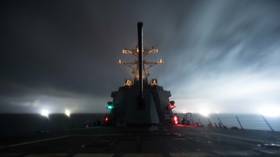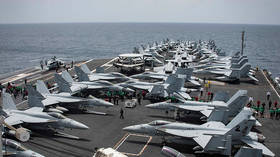‘The Chinese are coming’: US attempts to turn the Philippines against its Beijing ally

The US has capitalised on its trade war with China, the threat of terrorism and the regional military threats allegedly posed by Beijing to keep longtime allies such as the Philippines from turning against Washington.
China is now the second-biggest defence spender in the world, losing out only to the US (who – by the way – is so far ahead of the game that it accounts for 36 percent of all global defence spending). The rise of Beijing – and Washington’s response to its ever-emerging preeminence – is putting traditional allies of both China and the United States in an increasingly interesting position.
One such ally is the Philippines. In October 2016, Philippines President Rodrigo Duterte was so emboldened by his newfound anti-American stance that he even dared the CIA to try to have him removed from power (and ultimately assassinated).
“You want to oust me?” Duterte said at the time. “You want to use the CIA? Go ahead.”
Also on rt.com Duterte sees China as a menacing friend, ever since US failed to deliver promised armsAt around the same time, his administration also made clear Duterte’s intentions to realign his country’s foreign policy away from a “shackling dependency” on the United States. In September of that same year, Duterte allegedly said that while he does “not want a rift with America,” all US forces in the southern region of the Philippines “have to go.”
He even went so far as to make such outlandish promises as the US-Filipino naval drills taking place in September 2016 would be the “last military exercise.” Not long after, he announced his separation from the US while declaring that it was China, the Philippines, and Russia against the world. He even agreed to set aside an international tribunal’s ruling in favour of the Philippines against China, in an apparent effort to keep Beijing onside.
Despite his best efforts – whether genuine or not – Duterte has not been able to contain Manila’s relationship with Washington, nor has he been able to cement a long-lasting and non-confrontational association with Beijing.
Last week, Duterte found himself openly questioning China’s claims to the South China Sea, stating “I love China, it has helped us a bit but it behoves upon us to ask, is it right for a country to claim the whole ocean?”
Barely a few days later, a spokesman for Duterte said that the Philippines supports any US-led action in the South China Sea that would maintain stability in the region amid China’s expanding influence and militarisation of the area.
Also on rt.com US is heading toward a looming maritime showdown… but not with IranWhether anyone wants to admit it or not, I can’t help but feel that the US has something to do with Duterte’s failure to make any meaningful headway in this respect. While I don’t doubt the Philippines has genuine concerns about its standing in the region and Beijing’s ever-expanding intentions, statements such as the ones uttered by former Deputy Defense Secretary Robert Work to the Washington Post which read, “I would have said ‘The Chinese are coming, the Chinese are coming, the Chinese are coming,’” surely help inflame the situation.
The US-China trade war also puts the Philippines in an unusual position. According to a report by Japan-based Nomura, the Philippines could stand to gain 0.1 percent of its GDP from the US-China trade war as Philippines imports are set to greatly increase. This is true for many other regional allies of Washington who hold a strong distrust for Beijing’s activities in the South China Sea and beyond, such as Vietnam, Taiwan, and Malaysia – Vietnam being the largest projected beneficiary of the trade spat.
Most importantly, the trade war has shown Duterte that he cannot risk putting all of his eggs in one basket, and inevitably will have to at least maintain a decent relationship with the US in the interim.
The implications for these developments are quite profound. Just recently, a report published by the hawkish thinktank known as the Center for a New American Security warned that Beijing “appears increasingly close to achieving technological parity with U.S. operational systems and has a plan to achieve technological superiority.” The report further explained that China was well on its way to dominating local battle theatres (part two of its supposed three-stage plan), getting to such an advanced state of military readiness that war over the South China Sea or even Taiwan would be too costly for the US to pursue.
Also on rt.com ‘US has no honor!’ Duterte slams ‘bossy’ Washington for breach of arms dealSpeaking of Taiwan and the Philippines, there may be other reasons why turning Taiwan into a warzone may not be the best option on the table (though at the same time, these reasons may also make war that much more inevitable). For example, just this month, reports emerged that the Philippines will be building its first military base on Y’Ami Island on the northernmost tip of the country. The remote, uninhabited island is a mere 80 miles away from Taiwan and geostrategically faces a key waterway that connects the Pacific Ocean, the East China Sea and the South China Sea. China, for its part, has warned that its military will “resolutely take action” to defend its purported claim over Taiwan and “defeat all enemies.” China also threatened that it would not “yield a single inch of the country’s sacred land.”
And yet, at the same time, Beijing has reportedly acted to appease the concerns of its Philippines ally. The Manila Times recently reported that China had withdrawn around 100 Chinese vessels from Pagasa (Thitu) Island as “an initial gesture on the part of China to win the trust and confidence of the Philippine government.” If other recent reports are anything to go by, China will have its work cut out for it, as Filipinos allegedly continue to harbour deep distrust for China and its intentions in the region.
That being said, the potential for a conflict in this part of the world appears to continue to increase on a daily basis. Just last week, a Russian warship and a US warship came extremely close to colliding with each other, with both sides disputing which part of the sea the incident took place in (whether the Philippine Sea as the US suggested, or the southeast of the East China Sea as Russia claimed, I think you should be starting to get the point by now).
Also on rt.com No bother to them: Russian sailors spotted SUNBATHING during near collision with US destroyerWhile the Philippines ultimately will want to maintain a balance between the US and China which does not involve putting its territory at the heart of open conflict, another point worth noting is how the Philippines has been pursuing stronger military ties with an unlikely Washington ally, who undoubtedly has separate motives of its own: Israel.
According to the Diplomat, Israel and the Philippines seem set to move forward with joint counter-terrorism efforts, all the while the Philippines places large orders for a range of military equipment from Israeli firms. The Philippines is also hoping to learn directly from the Israelis as to effective counter-terrorism efforts by receiving direct training. Apparently, Israeli police have been very willing to share their skills and knowledge in this regard. Believe it or not, the forging of an Israel-Philippines relationship is somewhat fairly recent, as Duterte is the first Philippines president since bilateral ties were first established between the two nations in 1957 to visit Israel.
At the same time, the US and the Philippines have also reportedly collaborated to launch a three-year program to fight homegrown ISIS-inspired extremism in the Philippines. Because at the end of the day, the US will always have the threat of terrorism to keep the Philippines in line. In 2017, Duterte openly declared that he didn’t seek US support to help combat a militant uprising in Marawi City on the island of Mindanao, but the US military still found a way to show up and take part in counter-terrorism operations regardless. In this context, China may just not be able to compete with America’s wide-ranging ability to bomb Islamic militants right across the globe.
And like with most geopolitical chess games the US finds itself playing against Cold War rivals such as Russia and China, there is always an arms deal to be had in there somewhere.
Think your friends would be interested? Share this story!
The statements, views and opinions expressed in this column are solely those of the author and do not necessarily represent those of RT.















